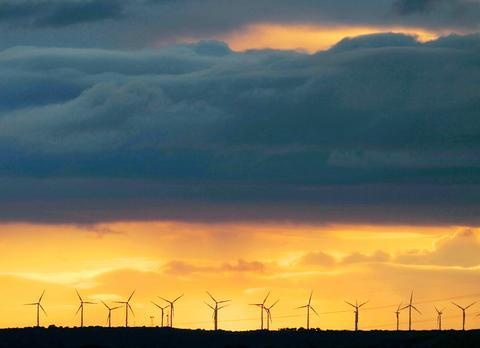Germany is the world's undisputed world leader in producing electricity from wind power after more than a decade of rapid expansion, but the country does lag behind in the final frontier of wind energy -- offshore windparks.
But now Germany's wind power industry is forging ahead with work starting on some of the first windparks in the North Sea and Baltic Sea in a development which many people hope will work out for a reason completely unrelated to a clean environment.
The derogatory term Verspargelung is making the rounds in Germany, a word which roughly means "turning into asparagus fields" -- an apt description of how the towering wind generators and their rotor blades resemble giant asparagus plants cluttering the horizon.

PHOTO: REUTERS
With more than 15,000 wind generators around the country, Germany produces as much electricity from wind as Denmark, Spain and the US all combined. By the year 2010, wind-generated electrical production is to be doubled once again.
But space is running out on land, and with opposition to windparks rising from various quarters, including the tourism sector worried about Germany's scenic landscapes, the industry is now heading offshore.
The federal maritime shipping and hydrography office (BSH) in Hamburg is now reviewing 30 applications for offshore parks, and four have been approved. The first offshore parks will be starting up in 2006 at the earliest -- years behind such facilities in Denmark, Sweden and England.
"We have made things more difficult for ourselves than others," commented Fritz Vahrenholt, chairman of the REpower wind engineering firm in Hamburg, referring to drawn-out debates and delays due to environmental impact considerations.
"It is really astonishing how a technology-oriented country like Germany always reacts with fear and loathing to everything that is new," added Sven Teske of the environmental group Greenpeace.
Besides economic feasibility considerations, nature preservation has dominated the debate over proposed offshore windparks. Amid many restrictions, it will mean that Germany's offshore parks will have to be positioned as far as 40km out at sea, with the windmills' concrete foundations having to be built at depths of 30m.
Greenpeace's Teske notes that at the moment, "there is no windpark anywhere in the world which is more than 15km offshore".
Vahrenholt, commenting on the concerns expressed that Germany's sea horizons could become cluttered with windmills and on the impact of offshore parks on the marine environment, noted:
"The density of the animal population is lower and the towers can't be seen from land [at that distance]."
As German firms prepare for the country's first offshore parks, some are reporting some major new developments. At Cuxhaven, the REPower company is now working on a prototype of a 5-megawatt generator -- about double the size of today's largest wind generators.
Soon to be tested on land, ultimately the 5-MW wind generator is meant for offshore. Its dimensions -- a tower 183m high and the rotor blade circumference of 125m, or more than the length of a football field, can only be feasibly put to use far out at sea.
Offshore windparks, particularly the further out they are and the deeper the water they have to be built in, pose much greater technical and engineering challenges than land-based windmills do, adding substantially to the costs.
A company in Rostock, Arcadis, hopes to substantially cut the costs with its "floating windmill."
The idea is first to build the wind tower, complete with its concrete foundation, in a harbor, and then to tow it offshore for final installation on the seabed. Such a facility can also be towed back to shore for repair and maintenance work, thereby reducing the technical challenge of performing such work out at sea.
Arcadis has won approval for a first prototype 2-MW floating windmill at the "Ventotec Ost 2" offshore windpark planned some 35km northeast of the Baltic Sea island of Ruegen. Ultimately, the offshore park is to have installed capacity of 600MW.
Under German government plans, by the year 2020, some 20,000 megawatts of electricity are to be derived from offshore windparks.

CALL FOR SUPPORT: President William Lai called on lawmakers across party lines to ensure the livelihood of Taiwanese and that national security is protected President William Lai (賴清德) yesterday called for bipartisan support for Taiwan’s investment in self-defense capabilities at the christening and launch of two coast guard vessels at CSBC Corp, Taiwan’s (台灣國際造船) shipyard in Kaohsiung. The Taipei (台北) is the fourth and final ship of the Chiayi-class offshore patrol vessels, and the Siraya (西拉雅) is the Coast Guard Administration’s (CGA) first-ever ocean patrol vessel, the government said. The Taipei is the fourth and final ship of the Chiayi-class offshore patrol vessels with a displacement of about 4,000 tonnes, Lai said. This ship class was ordered as a result of former president Tsai Ing-wen’s (蔡英文) 2018

‘SECRETS’: While saying China would not attack during his presidency, Donald Trump declined to say how Washington would respond if Beijing were to take military action US President Donald Trump said that China would not take military action against Taiwan while he is president, as the Chinese leaders “know the consequences.” Trump made the statement during an interview on CBS’ 60 Minutes program that aired on Sunday, a few days after his meeting with Chinese President Xi Jinping (習近平) in South Korea. “He [Xi] has openly said, and his people have openly said at meetings, ‘we would never do anything while President Trump is president,’ because they know the consequences,” Trump said in the interview. However, he repeatedly declined to say exactly how Washington would respond in

WARFARE: All sectors of society should recognize, unite, and collectively resist and condemn Beijing’s cross-border suppression, MAC Minister Chiu Chui-cheng said The number of Taiwanese detained because of legal affairs by Chinese authorities has tripled this year, as Beijing intensified its intimidation and division of Taiwanese by combining lawfare and cognitive warfare, the Mainland Affairs Council (MAC) said yesterday. MAC Minister Chiu Chui-cheng (邱垂正) made the statement in response to questions by Democratic Progressive Party (DPP) Legislator Puma Shen (沈柏洋) about the government’s response to counter Chinese public opinion warfare, lawfare and psychological warfare. Shen said he is also being investigated by China for promoting “Taiwanese independence.” He was referring to a report published on Tuesday last week by China’s state-run Xinhua news agency,

‘ADDITIONAL CONDITION’: Taiwan will work with like-minded countries to protect its right to participate in next year’s meeting, the foreign ministry said The US will “continue to press China for security arrangements and protocols that safeguard all participants when attending APEC meetings in China,” a US Department of State spokesperson said yesterday, after Beijing suggested that members must adhere to its “one China principle” to participate. “The United States insists on the full and equal participation of all APEC member economies — including Taiwan — consistent with APEC’s guidelines, rules and established practice, as affirmed by China in its offer to host in 2026,” the unnamed spokesperson said in response to media queries about China putting a “one China” principle condition on Taiwan’s